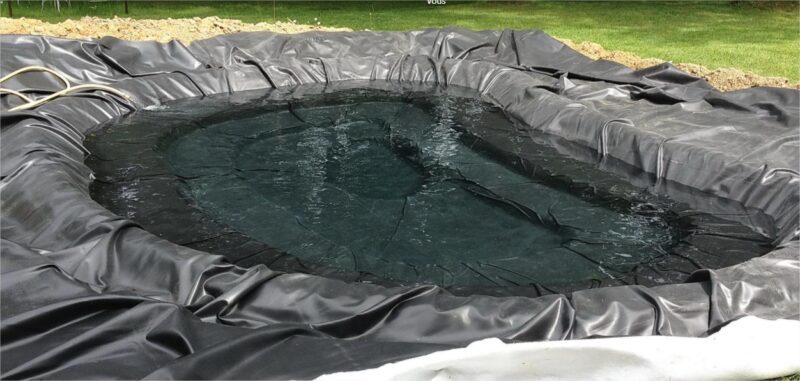How Much Ponding Is Acceptable on A Flat Roof?
Flat roofs can be a great addition if you want to add one to your latest construction project or replace your inclined roofs with a flat roof.
Flat roofs boast of modernity and have to an extent, if not completely, replaced the conventional inclined roofs.
Flat roofs bring a great many benefits that are part and parcel of the installation. However, they are much different from traditional sloping ceilings. To make the most out of your flat roofs, you need first to understand their mechanics and how they are different from the conventional downward sloping roofs.
Ponding is a common problem that can be associated with flat roofs since they are flat (duh!). In this article, we’ll be discussing ponding and flat roofs. We’ll also be discussing ponding levels that are considered acceptable if your home features a flat roof.
What are flat roofs?
In contrast to the many forms of slanted roofs, a flat roof is almost horizontal. The pitch of a roof is technically known as its ‘pitch.’ Flat roofs have pitches of up to 1-10 degrees but can reach 12.5 degrees. Flat roofs enable the roof space to be used as a living space or a living rooftop.
Flat roofing goods (2 layer bituminous felt systems) can be utilized in pitched / inclined roof situations if the proper application procedures are applied.
What is ponding?
Ponding occurs when water gathers in puddles on a flat roof during a period of extreme downpour and does not drain away once the rain stops. While brief and infrequent ponding is okay on a flat top, persistent or long-term ponding may symbolize that there is an issue with the roof that needs to be rectified.
According to the National Roofing Contractors’ Association (NRCA), any amount of standing water that stays on your flat roof for 24 to 48 hours is considered ponding.
Although an immediate leak is unlikely, frequent ponding can cause damage to the roof and allow it to degenerate before its age. The real kicker is that ponding will not cause immediate harm or violate your flat roof warranty.
Why does ponding occur?
There might be a plethora of reasons behind why ponding occurs on your flat roofs. The most common causes of ponding include:
- Insufficient or a very lowly inclined slope on your flat roof.
- Non-functioning, impaired, or blocked drains.
- A less than satisfactory drainage system.
- Depressions or dips in the flat roof’s surface.
- Flat roof material that is chipping off.
- A drooping or sinking roof deck.
Flat roofs are more likely to bleed because they are less capable of shedding water. In other words, they do not enable elements such as water to slide off them like steeply pitched roofs do simply. All roofs are slanted at least a few degrees to prevent standing pools of water.
HVAC equipment put on the roof’s surface can also cause ponding because it is overly heavy and generates a dip in the roof. Ponding water might also be caused by natural condensation or an abnormal leak from the air conditioner. The water may be slowly emptying, but the equipment is replenishing it. In this instance, an HVAC technician will be required to repair the equipment’s leak or redirect the typical condensation.
How does ponding damage a flat roof?
Flat roofs can add the final artistic touch to your contemporary home style. However, ponding may cause these roofs to deteriorate, making the final sight not so pleasant.
Yes, any levels of ponding do damage flat roofs due to the constant water that is being bucketed by your roof. Here’s what ponding does to flat roofs:
- The additional weight bagged by the standing water puts extra stress on the roof, and this weight is detrimental to the health of the roofing material that is being used in your flat roof and damages it.
- The standing water may seep through your roofing material, not only damaging the outsides of the flat roof but also damaging the internal ceiling of your homes – a phenomenon more commonly known as ceiling seepage.
Roof seepages are commonly signified by yellow patches on the ceiling, closely followed by a musty odor.
- Ponding also instigates moisture-related problems, such as the growth of moss and algae. Standing water also provides breeding grounds for bugs and insects, multiplying their population.
Ponding and flat roof – How much ponding is acceptable on a flat roof?
The great news is that ponding is not a serious issue if your roof is constructed with suitable materials and correctly built with an effective drainage system. Ponding that drains or evaporates within two days is safe and not cause for alarm, but ponding that occurs on a regular basis should be addressed.
If the ponding persists after two days, you should consult a professional roofer since this indicates that the roof drainage system is malfunctioning or that there is an issue with the sloping roof, roofing material, or roof deck.
Most single-ply manufacturers demand that 80% of water be removed from a roof within 48 hours following a rainstorm. So, if there are a few locations on the roof with ponding water after 48 hours, it is within the roof system’s design.
Ponding water is less flexible in most coating techniques. Requirements vary, but in general, if there is ponding water, coating warranties either exclude these areas or mandate the use of a more costly and heavy-duty flashing grade coating.
How much slope is acceptable to prevent ponding on a flat roof?
In general, the minimum slope for water to flow down is 1% (1/8″ per 1′). However, the minimum pitch for a flat roof required by building regulation in most areas in the United States is 2%. (1/4″ per 1′). If you have a lowly inclined slope, you will most likely require membrane roofing to prevent ponding.
Moreover, it would help if you didn’t have dips or depressions on your flat roof. Consequently, puddles should not form on a roof since roofs are not meant to support the weight of a considerable amount of water.
How to solve, reduce and prevent ponding on a flat roof?
Ponding can turn into a nasty problem if you don’t take precautionary or corrective measures to tackle it. Here’s what you can do to prevent ponding on your flat roof.
Use a scupper box
Scupper boxes are custom-made components used to drain water from a roof via a wall. These pieces are frequently utilized as an overflow prevention mechanism, operating as an additional drain on a specific roof.
Consider a scupper box and downspout if the ponding water is at the flat roof structure’s edge or if inside plumbing is not an option. Installing a new scupper box, downspout, and a ‘sump’ insulation along the border would be required to utilize this technique fully.
Sump insulation simply implies that the insulation around the scupper box is lower than the surrounding roof, which aids in drainage. If necessary, you may additionally cut a more extensive passageway to allow water to flow to the downspout.
Improve your drainage system
If your flat roof lacks the correct number of drains, there’s a high chance that it will result in ponding. If you can easily tweak your internal plumbing, you can add additional drains to allow precipitation water to drain through them, efficaciously preventing ponding. You can even gear your new gutters with sump-ed insulation to make the process even better.
You must also make sure that your existing gutters, drains, and pipelines are free of debris and clean.
Think about getting a tapered roof system
Tapered roof systems are great at preventing ponding on flat roofs. Tapered roof systems feature tapered insulation that has little ‘pitch’ to it. Typically, this pitch is around 1″ over 8′, 1″ over 2′, or 1″ over 4′.
The tapered system has a significant effect on perfectly flat, ponding-prone roofs. The disadvantage of tapered insulation is its high cost. Creating a slope like this on a flat commercial roof system can significantly increase the amount of insulation necessary.
Furthermore, constructing a tapered roof system is similar to assembling a jigsaw; each component has a particular location. As a result, adding a tapered roof system can significantly increase the cost, and it often adds 30% to 50% to the entire cost of the project. So, if you’re willing to bear the expenses, tapered roof systems are just what your flat roof needs.
Pay attention to tear-offs.
Ponding can be a result of soaked or impaired insulation. Nipping this problem in its bud can prevent ponding from occurring on your flat roofs. You can do this by repairing or replacing the damaged piece of insulation as soon as you see it.
Looking for professional help
If you suspect that your ponding problem is due to a structuring issue of your flat roof, it’s time you seek professional help. You may be dealing with a sinking roof deck, wrongly installed joists, beams, frames, or have an insufficient slope. In these circumstances, you should call a professional roofer to advise you on the best way to solve this problem.
Furthermore, if you’re not sure about the root cause of your ponding issue, professional help is still the best bet. These professionals will find the source of the problem for you and nip it right in the bud!
No more ponding!
Flat roofs indeed pack a number of benefits and give that contemporary look to your abode. Flat roofs may be unpopular among some people because of the ponding issue talked about in this article.
However, ponding is 100% preventable and solvable, and you don’t have to compromise on your dreams of embellishing your house with a flat roof just because of this. Without the ponding issue, flat roofs pack all the features of the conventional inclined roofs and more!
FAQs
Is ponding on a flat roof normal?
Ponding occurs when water gathers in pools on a flat roof during a period of heavy rain and does not drain away once the rain stops. While brief and infrequent ponding is okay on a flat roof, persistent or long-term ponding may symbolize that there is a problem with the roof that needs to be rectified.
Is it okay for water to sit on a flat roof?
The surface should be level, and pools of water should never form on top of a well-fitted flat roof. If water stays on the roof for an extended amount of time, it can generate a buildup of silt, which can harm the membrane if it freezes.
How do you get rid of ponding on a flat roof?
The roof must be leveled if it sags or has little uneven patches. You may purchase a DIY flat roof leveling compound kit that includes everything you need to pack in the dip and seal it with a waterproof finish. You can also use it to make slopes to guide water to drainage outlets!
How do I stop ponding on my flat roof?
The first is via roof scuppers, which are collector heads that lead to downspouts. The second method involves sloping towards a gutter system that directs water away from the roof. The third method is to use roof drains, and water should flow away and avoid ponding if roof drains and gutter systems are kept clean.
Is ponding on a flat roof a problem?
Ponding water is not a concern on an excellent flat roof since it will drain or perhaps evaporate away. Ponding water, on the other hand, does not disperse when your flat roof has uneven patches owing to sagging, an inadequate slope, or drainage concerns.
Is pooling on a flat roof bad?
‘Ponding’ of any sort indicates inadequate water drainage and will undoubtedly lower the roof’s life expectancy, causing structural damage, leaks, and potential plant growth over time. Ponding on flat roofs can develop for a variety of causes.










